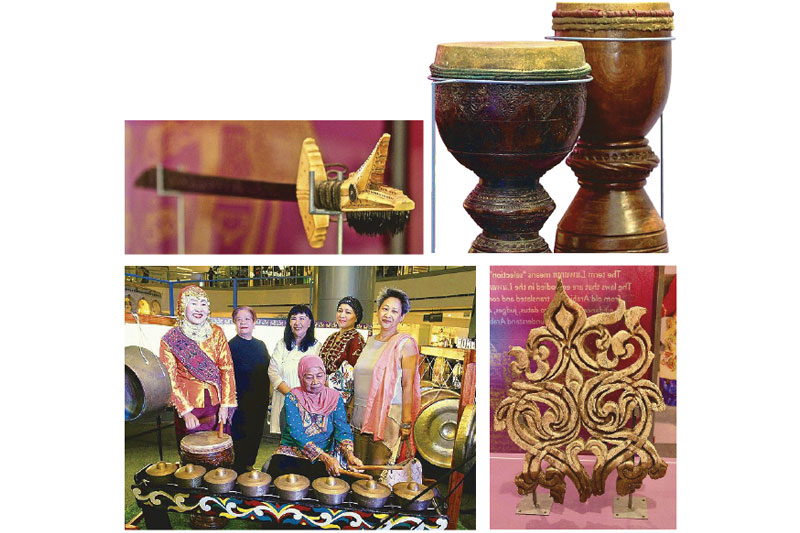A moving exhibit

Curator Marian Pastor Roces (right) is joined by (fromleft) Mona Acmad, Museo ng Kaalamang Katutubo executive director Corazon Alvina, SM vice president for Marketing and Communications Millie Dizon, Anak Mindanao Party-list Rep. Sitti Djalia Turabin-Hataman and kulintang musician Aga Mayo Butocan.
MANILA, Philippines - The “Muslims of the Philippines: History and Culture” exhibit is moving both physically – it’s a traveling exhibition – and emotionally, in that it comes at a time when the conflict and subsequent martial law in Mindanao makes understanding the culture and history of the region especially relevant.
Now on its second edition, the exhibition is being mounted by Anak Mindanao Party-list and TAO Inc., sponsored by the Autonomous Region in Muslim Mindanao government and the SM Group of Companies.
Launched earlier this year at SM North Edsa, the second leg of the traveling exhibition was held at the SM Aura Premier at Bonifacio Global City on June 26, marking Eid’l Fitr, the feast ending the observance of Ramadan. The third leg is being planned for Eid’l Adha in September.
According to TAO Inc., “The exhibition aims to be a compelling portrayal of Muslim Filipinos in a way that has never been done before. It challenges stereotypes by close views of a historical timeline, of a presentation of archival photographs, of examples of intricate Muslim Filipino art, and of rare artifacts.”
The exhibit uses illustrations, photographs, videos, as well as artifacts to give viewers a glimpse of the Muslim culture and history in the Philippines, with history dating back hundreds of years all the way to photos of elegantly-dressed contemporary Muslim Filipinos representing Maranao, Maguindanao, Iranun, Sama and Tausug. An extensive timeline traces the arrival of Islam in the Philippines all the way to contemporary times. Antique swords, textiles, carvings, musical instruments and brassware further concretize the intricacy of Muslim culture for the viewers.
“Muslims of the Philippines” also aims to bring to the fore information that is not being discussed or noticed in mainstream Philippines. “The exhibition adds to the knowledge base, not only about Muslim Filipinos as a unique population segment, but about a kind of culture and history that has persisted through tremendous conflict and challenges.”
Curator Marian Pastor Roces says, aside from dispelling some negative Moro stereotypes, the exhibit was also conceptualized to foster cultural understanding. Further, the exhibit gives a platform to arts and culture which has been destroyed amid the destruction caused by armed conflict in Mindanao. “The question is: is there room for memory? Can memory mobilize understanding?” she asks.
The traveling aspect of the exhibit is important as it brings the museum to the mall – closer to the audience, Roces points out. Aside from malls, the exhibit is designed to travel to schools, corporate and government offices and other public spaces.
For the second leg of the exhibit, the curator found the need to add a section dedicated to Marawi. The additional materials include photographs of places and art in Marawi that have already been destroyed in the ongoing conflict. “It’s not there anymore,” says Roces. “There’s a certain amount of sadness when it comes to this exhibition.”
Roces adds it is not only the art or landmarks of Marawi that have been affected, but also a deep memory. The exhibit is one way that these memories can be preserved.
Aside from photos, a highlight of the Marawi section of the exhibit is a literary piece written by Elin Anisha Guro who is from Marawi City, but now resides in Melbourne, Australia.
Written on June 6, Guro begins, “Good night world. And my beloved Marawi City profusely burns, like a sacrificial woman offered to the monster…”
The original English text is translated to many different languages including Filipino, Tausug and even Japanese.
Guro’s lament as she watches her hometown burn from afar ends on a triumphant note that perhaps brings the exhibit on history and culture into the possible future of Muslims of the Philippines: “Like the Phoenix, you will be reborn from your ashes to a new Marawi. Or to your old glory – Dansalan. Though broken, betrayed and bleeding, you will overcome all of these to be with the loving embrace of your sons and daughters…
“You will rise, my beloved city. Your true sons and daughters and your adopted children await you. Those who have set you on fire will one day rue that they were ever on the wrong side of your story.”
Moving in many ways, the exhibit brings the culture and history of Muslims of the Philippines closer to the everyday consciousness – and hopefully cultural understanding – of Filipinos nationwide.
- Latest
- Trending


















